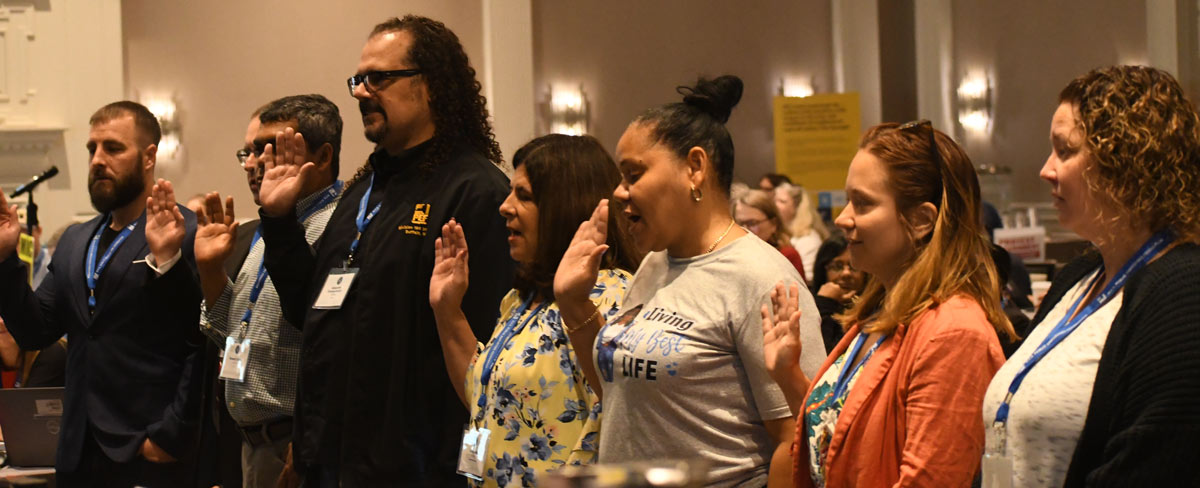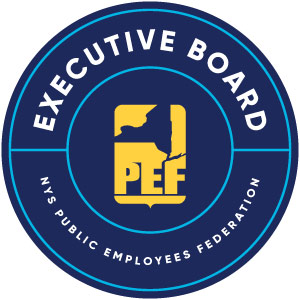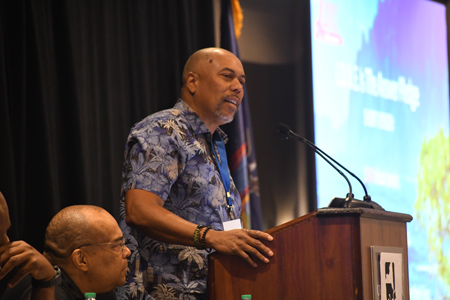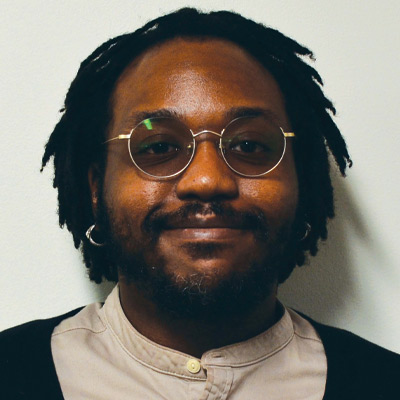
 October 7, 2025 — The PEF Executive Board met for its quarterly meeting on September 18 and 19 in Albany. With one month to go before the 47th annual Convention in Lake Placid, the meeting focused on the union’s convention plans, upcoming contract negotiations, the future of Civil Service, and membership engagement and finances.
October 7, 2025 — The PEF Executive Board met for its quarterly meeting on September 18 and 19 in Albany. With one month to go before the 47th annual Convention in Lake Placid, the meeting focused on the union’s convention plans, upcoming contract negotiations, the future of Civil Service, and membership engagement and finances.
Appointments and retirements
At the start of the meeting, PEF President Wayne Spence acknowledged eight new Executive Board members: Adam Warrenchak, Bradley Rosen, Biswajit Datta, Alexandre Donascimento, Laurie Kail, Angelina Rodriguez, Kristina Tereburke and Jill Poeller. All eight members were sworn in at the meeting.
President Spence also announced the retirement of two members, Sabu Cherian, a Vocational Instructor 2 at DOCCS Green Haven Correctional Facility, and Steve Drake, an Education Supervisor at DOCCS Mohawk Correctional Facility. Drake was one of the PEF representatives tapped to work on reforms to the Humane Alternatives to Long-Term Solitary Confinement (HALT) Act following the wildcat DOCCS strike in March.
Drake cited the strike and the culture at DOCCS as a reason for choosing to retire now.
“It really was a difficult decision, and it isn’t something I decided on quickly,” Drake told the board. “But with the way things are going and after the DOCCS strike, I do not see myself continuing on with the agency.”
President Spence echoed Drake’s sentiments. Although many states are experiencing issues with their criminal justice systems, President Spence said that conditions in New York correctional facilities remain dire.
“We have to make sure that everyone who works behind the walls—whether they are an incarcerated individual or people who work there—are safe,” said President Spence. “We have to look at the issue at DOCCS from various perspectives.”
Following the retirement announcements, President Spence introduced PEF’s new General Counsel John Svare and Deputy General Counsel, Alison Thorne. Svare was promoted from deputy after former General Counsel Ed Greene accepted a legal position with the Public Employment Relations Board.
Vacancy filled
An election was held on the floor to fill a vacancy to the Policial Action Advisory Executive Committee (PAAEC). The vacant seat was held by Vincent Cicatello, who can no longer serve now that he is Region 1 Coordinator.
After two rounds of voting, the board elected Keith Browne, an Assistant Environmental Engineer at the DEC, to the position.
COPE and Membership Engagement
COPE (Committee on Political Education) Coordinator Don Morgenstern informed delegates they and their constituents can now contribute to PEF’s federal lobbying efforts via the PEF app.
“The new COPE button under Resources on the app leads to information, forms and sign-up sheets,” said Morgenstern. “Hopefully, this should make COPE much easier, now that it is entirely electronic and online.”
Morgenstern said that PEF’s international parent union SEIU has raised expectations for the union, given PEF’s success in growing its membership.
“More members mean more money,” said Morgenstern. “Thankfully, we have seen increases in both.”
COPE contributions increased by nearly 10% last year and total contributions sit at just over $203,000. A regional breakdown shows that PEF Region 2 leads with the most contributions, with 9 percent of the region’s members contributing. COPE is the only way PEF contributes to lobbying on the federal level, which is more important than ever given the current anti-union sentiment in Washington, D.C.
PEF Organizing Director Scott Harms then updated the board on the union’s membership engagement efforts.
“Trends show that our efforts to increase membership are working, and thanks to hiring at agencies, we are bringing a lot of new members in,” said Harms. “Organizing does need everyone’s help to make sure that we are not missing any potential new members. It is important that we remain vigilant and reach out to all new employees when they first start work.”
As of Sept. 8, 2025, the number of active dues-paying members is 55,270 – that’s a member density of 91.4 percent. But as the union’s membership grows, so does the number of non-members. Outside organizations continue to try to deceive members into opting out of PEF. Harms stressed that the union has protocols in place to try and prevent opt outs.
“We average about eight opt outs per month and continue to do a tremendous job at preventing these efforts,” said Harms. “We continue to look at different trends and come up with new ways to combat these efforts to harm our union.”
Finally, Harms delivered news about a combined PEF membership and COPE contribution application.
“Following guidance we received from our parent unions, we designed a one-page combined membership and COPE application,” said Harms. “By having both the membership and COPE applications on the same page, experience has shown that we will get more people to sign up for COPE.”
An electronic version of the paper form exists as well, making signing up new members easier across multiple platforms. All new membership kits mailed to bargaining unit employees contain the updated form.
Contract Telephone Town Hall and NY HELPS Update
President Spence hosted a Telephone Town Hall on Sept. 10 to update members on the status of the New York Hiring for Emergency Limited Placement Statewide (NY HELPS) program and contract negotiations.
NY HELPS is set to end in June 2026. At the Executive Board meeting, PEF Civil Service Enforcement and Research Director Veronica Foley said that NY HELPS was presented by the State as a temporary recruitment solution following the COVID pandemic. PEF is concerned that new “transformation” plans degrade our merit and fitness protections further.
“This potential move forward would expand the use of training and experience (T&E) evaluations,” said Foley. “But it walks, looks like, and talks like NY HELPS. Like NY HELPS, this plan is not codified in law and runs counter to our State’s Constitutional mandate of competitive examinations.”
PEF has never had an issue with T&Es, and many PEF members were hired through NY HELPS in the last few years. PEF is concerned, however, that moving away from competitive examinations puts civil servants and the New Yorkers they serve at risk. Members are urged to contact the NYS Department of Civil Service via PEF’s digital letter-writing campaign.
FACT SHEET: Why PEF opposed NY HELPS and the State’s plan to change the Civil Service system
President Spence also spoke to the board about the union’s contract. PEF sent a demand-to-bargain letter to the Office of Employee Relations (OER) suggesting dates to begin bargaining for the next contract. PEF’s current contract with the state ends on April 2, 2026.
The response PEF received from OER stated that because of federal budget cuts and the recent “One Big Beautiful Bill” Act passed by the U.S. House and Senate, the state is not ready to begin negotiations as they are unsure what the state budget will look like.
In response, PEF offered to commence negotiations on “non-economic” items, like accruals and sick time. President Spence said that by tackling these items ahead of wage increases and cost-of-living adjustments, the union stands to gain momentum and be ready to negotiate the rest of the contract when OER has a better sense of the state’s financial outlook.
“The point is to get moving now,” said President Spence. “Our team is trained and ready to negotiate. We know that wages and other economic increases are important—they are always important—but we have an opportunity to get the ball rolling and keep it rolling by beginning on whatever items we can. This is our strategy.”
PEF financial report
“I am proud to report that PEF has never been in a better financial position than it is now,” PEF Secretary-Treasurer Joe Donahue told the board. “The unbelievable accomplishments by the Organizing Department have increased our dues paying members and the fiscal strength of our union.”
As the third quarter of this year began, Secretary Donahue reported total income for the union at $2,059,491. He anticipates revenue rising as more members join PEF.
“While it is still early to project, we predict that revenue will continue to grow as we bring more members into the union and as we continue to stop opt-out attempts,” said Donahue.
Some budget items were approaching a 10 percent over-budget threshold, but Secretary Donahue said that recommendations for budget amendments were not necessary at this time.
Legislative update
The Executive Board approved both the State and Federal Legislative Agendas for 2026 to be debated and voted on by Convention delegates next month in Lake Placid.
PEF Vice President Randi DiAntonio, who chairs the union’s Statewide Political Action Committee, then updated the board on PEF-supported bills that were signed into law by Governor Hochul and bills that still await the Governor’s signature before the end of the year.
“The first bill that we advocated for that passed was a bill on Artificial Intelligence (AI),” she said. “This bill put guard rails in place related to how AI is being used in the state workforce and agencies.”
Another law passed by the Governor cited by VP DiAntonio expands workers’ compensation benefits to include mental injury, and a third calls for the Department of Corrections and Community Supervision to develop heat mitigation plans in their old facilities, some of which can reach over 100 degrees Fahrenheit in the summer months.
There are a number of bills still awaiting the Governor’s signature, including the LOADiNG Act, which expands the guard rails around AI to SUNY, CUNY and municipal governments, and a bill which would expand the number of days for paid leave for public employees performing military duties from 30 to 60.
“There are also ongoing efforts to introduce new Tier 6 legislation,” said Vice President DiAntonio. “As many of you know, we are working in coalition with other unions to equalize the pension system.
In closing, Vice President DiAntonio shared that the budget outlook for New York State looks shaky, with about $10-15 billion in federal funding cuts likely.
“Thirty-eight percent of our entire state budget comes from the federal government. That’s about $90 billion,” she said. “We are expecting reductions to Medicaid and SNAP, which our members help administer for the people of New York. And we are expecting education funding cuts in the billions. This could affect all of our lives and the things we’re fighting for in our next contract.
New York does have a rainy day fund to cover potential losses, but how much of that money will be used to sustain specific services whose funding gets cut by the federal government is yet to be determined. In the meantime, PEF members are encouraged to stay informed via the union’s website, where they can also record a testimonial sharing with State lawmakers the impact federal cuts will have on the services they provide and the communities they live in.
Other business
The Convention Committee presented their agenda for the 47th Annual Convention, which will take place Oct. 19-22 in Lake Placid, N.Y. The board voted to approve the proposed agenda as presented with no changes. The three-day gathering will feature the most delegates in years – 731 as of this writing – who will set the agenda for the union in the year ahead.
The Executive Board also voted to approve the Divisions Committee recommendation from five unrepresented members at SUNY Alfred who petitioned to join PEF Division 201.

On the second day of the meeting, Sept. 19, President Spence invited A.J. Ali, the founder and CEO of “L.O.V.E. is the Answer,” to address the body. President Spence attended one of Ali’s workshops while at the National Organization of Black Law Enforcement Executives (NOBLE) conference earlier this summer. Ali’s life philosophy focuses on learning, openness, volunteering and empowerment. Spence believes that the slow movement of government agencies—like OMH, DOCCS, OCFS and others—to address the health and wellbeing of its workforce, means that the union must step in and via things like the Employee Assistance Program (EAP) learn how to address issues for themselves.
“Why would we try to take training from people who do not understand what we’re experiencing?” he asked the board. “We need to help ourselves and we need to figure this out for ourselves because we’re the ones experiencing these issues.”
The program and workshops pioneered by Ali have been used at law enforcement agencies across the country. President Spence invited the Executive Board to introduce Ali’s programs at Labor Management and Health and Safety meetings to begin addressing ways to improve the mental and physical health of staff.
The next PEF Executive Board meeting will be held December 4 and 5 in Albany.

